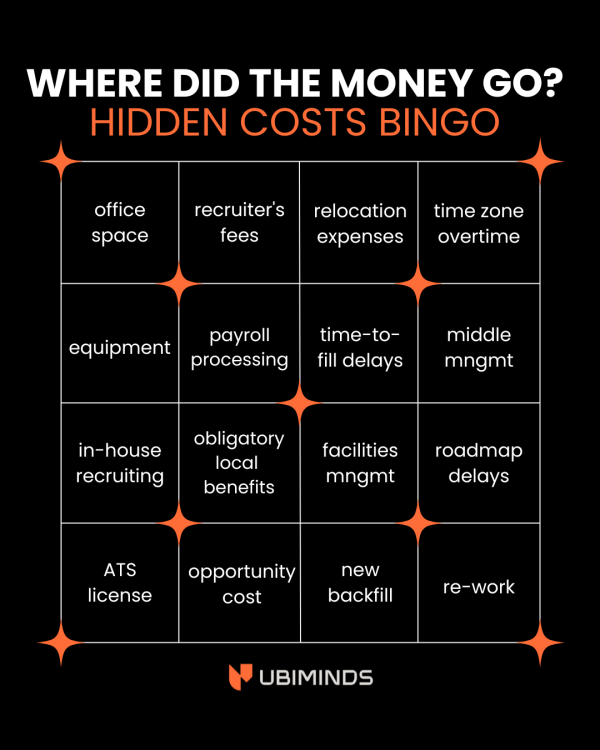Hidden staffing costs can silently drain your budget in tech hiring. Beyond salaries, consider tech recruitment costs, staffing cost optimization, and hidden expenses of internal hiring or external contractors. Learn how to reduce hidden staffing costs with strategic hiring, cost-effective recruitment, and team structure optimization.
Understanding hidden staffing costs is crucial for any business looking to optimize its hiring process. From hidden recruitment costs to unexpected staffing expenses, these unseen charges can significantly impact your bottom line. This guide reveals the true financial impact of hiring and offers strategies to manage unseen recruitment costs effectively.
The Hidden Truth About Staffing Costs in Tech
You have a budget to stick to, just like every other department in the company. But as someone who has had to hire one (or several) software developers, you know they are costly and in high demand.
When the time comes to scale your digital product team, chances are you will act as most leaders:
- First, you’ll look at the product roadmap and figure out what kind of team you need to set up to get it done.
- Second, you’ll evaluate your product team’s skill set and decide between training current staff, or hiring someone new. It’s a matter of opportunity cost.
- Third, you’ll leverage your internal recruitment team, or begin your search for contractors, or both simultaneously.
Asking your peer group for referrals is a great way to filter out any bad vendors. You’ll arrive at a shortlist of candidates and staffing firms or software houses fast. But how many of those take into consideration only the fees, but not the other associated costs regarding the new hires? When evaluating the full impact of your workforce, hidden staffing costs can silently drain your budget without you realizing it.
What are the Costs Involved in Building Delivery Teams?
This is a rich conversation that deserves an in-depth look to identify non-intuitive expenses.
Beyond Salaries: Unveiling Hidden Costs in Tech Hiring
When hiring tech talent, it’s easy to focus solely on salaries. However, different expenses are associated with the hiring process you choose, and they will impact your bottom line before and after the IT professional has been hired, onboarded, and placed within your development cycle.
This section explores these hidden costs and provides insights on how to optimize your tech hiring strategy. To begin with, companies must carefully assess outsourcing vs. in-house hiring to determine the most cost-effective hiring strategies for their needs. To achieve staffing cost optimization, consider:

Hidden Cost #1: Hiring In-House
Whenever you hire a software developer or any other IT professional, there are costs. The obvious ones are salary and fringe benefits — which usually add at least 20% on top of the annual salary you have agreed on.
- Direct Costs: Salaries, benefits, office space, equipment, and HR support.
- Indirect Costs: Time and resources spent on internal recruitment, onboarding, and training.
- Opportunity Cost: Potential lost revenue or productivity if the hiring process takes too long.
The truth is that finding and attracting talent takes up time, effort, and resources — unless you use Ubiminds, which recruits for free!
Hidden Cost #2: Outsourcing to Recruitment Firms or Staffing Agencies
As for the hiring of IT professionals, what happens if you opt for outsourcing the recruiting? Well, you should know these companies work with two systems:
- Contingency recruiting is often the fastest way to fill roles that are easier to fill. You can pitch the position to several companies, and they’ll charge 20% to 40% of the candidate’s annual salary as a fee.
- Retained recruiting is great for strategic roles with scarce candidates (let’s say, your next CTO). You ensure exclusivity to the selected company and depend on its pace to fill the role. Rates go up to 50% of the annual salary in most cases. Sometimes a retainer fee may be included.
Budget-wise, that means that on top of payroll expenses, there are various acquisition fees included as additional costs.
Also, hiring agencies have no concern about retention, and you’ll also have to pay extra in case of attrition. Here is an alert: backfills are charged separately in these cases.
Have in mind:
- Agency Fees: Contingent or retained fees based on the candidate’s salary.
- Additional Costs: Potential backfill fees, attrition costs, and administrative expenses.
FYI, Ubiminds doesn’t charge for backfills, either. We offer unlimited replacements so you can change strategy freely (scaling or downsizing at will) and have the freedom to promote Ubiminders to new positions. We’ll find you another top performer at no additional cost.
Hidden Cost #3: Opting for External Contractors
There are tons of software houses and app development firms out there. Offshoring to Eastern Europe (Poland, Ukraine, Russia) or Southeast Asia (India, Bangladesh) is common, but it could end up impairing both product development and budget.
Since these engineers are not in full synergy with your own product team, this often implicates:
- Communication Challenges: Overcoming language barriers and time zone differences.
- Integration and Collaboration: Ensuring seamless integration of external contractors with your internal team.
- Quality and Efficiency: Potential risks of lower quality work or delays due to miscommunication.
Results vary, but unwelcome surprises may include:
- Re-work, having to fix or adapt dirty or non-conforming code;
- Weird hours for team collaboration and leadership, who put up with incompatible time zones to communicate;
- Added management tier, to enable collaboration and integration.
This delays the development cycle, possibly compromising efficiency, quality, and competitiveness. You may even end up hiring more engineers than you actually need, having to compensate for lack of seniority or skill.
At the end of the day, hybrid staffing models can balance costs and expertise. HR professionals, hiring managers, and team leaders should identify needs, assess costs and benefits, develop a strategy, and effectively manage the hybrid team.
Hidden Cost #4: Overhead
Do you want to have this professional working in-house or co-located in your office? That means added expenses such as rent, facilities, and equipment. Offices also require concierge services and facility management to stay up and running.
Internal employees require HR support, and that has to be accounted for too. If they were previously living in another city, you will likely have to pay for relocation expenses if they are not working remotely. Have you taken these into consideration?
- Office Space: Rent, utilities, maintenance, and furnishings.
- Equipment: Computers, monitors, software licenses, and other necessary hardware.
- Facilities Management: Concierge services, cleaning, and security.
- HR Support: Payroll processing, benefits administration, and employee relations.
- Relocation Expenses: Costs associated with relocating employees to a new location.
As you can see, these expenses often go unnoticed and can significantly impact your hiring budget, making it essential to implement cost-effective hiring strategies.
How to Factor in Hidden Costs When Hiring
To make informed decisions about your tech hiring strategy, it’s essential to consider all associated costs, both direct and indirect.
Consider Staffing ROI
Understanding ROI helps make data-driven hiring decisions and ensures alignment with business goals. HR professionals, hiring managers, and team leaders should be involved and can calculate ROI by comparing benefits (e.g., increased revenue) to costs (e.g., salary, benefits, recruitment fees).
How to Calculate the Quality of Hire:
- Identify key performance indicators (KPIs): Determine the metrics that will measure the success of the new hire, such as increased revenue, improved customer satisfaction, or reduced costs.
- Estimate the costs: Calculate the total cost of hiring, including salary, benefits, onboarding, training, and any additional expenses.
- Measure the benefits: Track the impact of the new hire on the identified KPIs over time.
- Calculate ROI: Divide the net benefits by the total costs to determine the ROI.
Best Practices for ROI Assessment:
- Set clear expectations and goals: Clearly define the role and responsibilities of the new hire to ensure they are aligned with your business objectives.
- Track performance: Regularly monitor the new hire’s performance against the established KPIs.
- Continuously evaluate ROI: Re-evaluate the ROI of your hiring decisions over time to ensure they remain aligned with your business goals.
Assess Impact on Existing Team
A well-integrated new hire can positively impact team dynamics and productivity. Team leaders, HR professionals, and hiring managers can assess the impact by looking at team dynamics, identifying skill gaps, assessing workload distribution. You can also gather feedback from current team members.
How to Evaluate Team Needs:
- Analyze team dynamics: Evaluate the current team’s strengths, weaknesses, and areas for improvement.
- Consider skill gaps: Identify any skill gaps that the new hire can fill.
- Assess workload distribution: Evaluate how the new hire will impact the workload of existing team members.
- Conduct team interviews: Gather feedback from current team members about their expectations for the new hire.
Best Practices on Improving Dynamics With Staffing:
- Involve the team in the hiring process: Allow current team members to participate in interviews or provide feedback on potential candidates.
- Provide clear expectations: Clearly communicate the new hire’s role and responsibilities to the existing team.
- Facilitate integration: Organize team-building activities or mentorship programs to help the new hire integrate into the team.
Compare Costs and Benefits
Cost-benefit analysis helps make informed decisions about hiring options. Weigh the costs and benefits of different hiring options, including internal hiring, recruitment agencies, and external contractors.
HR professionals, hiring managers, and finance teams can come together to identify costs and benefits, calculate ROI, and consider long-term implications.
How to Study Costs:
- Identify costs: List all the potential costs associated with each hiring option, including salaries, benefits, recruitment fees, agency fees, and overhead expenses.
- Identify benefits: Identify the potential benefits of each hiring option, such as increased productivity, improved efficiency, and enhanced innovation.
- Calculate ROI: Quantify the potential return on investment for each hiring option by comparing the benefits to the costs.
Best Practices on Cost Analysis:
- Use data-driven decision making: Base your analysis on quantitative data and metrics.
- Consider long-term costs and benefits: Don’t just focus on short-term costs; consider the long-term impact of each hiring option.
- Involve multiple stakeholders: Get input from HR, finance, and team leaders to ensure a comprehensive analysis.
Our Job Evaluation: Getting Real About Pay and Setting Fair Salaries article will surely help.
5 Strategies for Building a High-Performing Team Without Breaking the Bank
When scaling your tech team, it’s essential to optimize your staffing costs without compromising quality. This section explores strategies to reduce development costs while maintaining high standards.
Strategy 1: Optimize Your Hiring Process
- Leverage data-driven decision making: Use HR analytics to identify trends, optimize processes, and make informed hiring decisions.
- Focus on quality over quantity: Prioritize hiring top-tier talent, even if it takes longer.
- Consider alternative sourcing methods: Explore options like employee referrals, social media recruiting, and online job boards.
- Negotiate compensation packages: Negotiate salaries and benefits strategically to achieve cost savings without compromising talent acquisition.
Strategy 2: Optimize Your Team Structure
It really depends on your company’s current context. Are you scaling? Have you been invested in? Sometimes it is more reasonable to replace two mid-levels for a senior whose experience and productivity will more than make up for that shift. Or, you can keep your internal digital product team and opt-out of traditional contractors.
- Evaluate team composition: Assess if your team structure is optimal for your current needs and goals.
- Consider restructuring: If necessary, restructure your team to improve efficiency and reduce costs.
- Upskill existing team members: Invest in training and development to enhance the skills of your current team members.
Strategy 3: Leverage Technology
- Utilize automation tools: Implement tools to automate repetitive tasks and improve efficiency.
- Optimize software and hardware: Ensure your team has access to the necessary tools and technology to perform their jobs effectively.
- Explore cloud-based solutions: Consider cloud-based platforms to reduce infrastructure costs and improve scalability.
Strategy 4: Foster a Productive Work Environment
- Create a positive team culture: Foster a supportive and collaborative environment that encourages innovation and productivity.
- Optimize communication and collaboration: Implement effective communication channels and tools to streamline workflows.
- Provide opportunities for professional development: Invest in training and development programs to keep your team motivated and engaged.
Strategy 5: Partner with Ubiminds
- Access a nearshore talent pool: Tap into Ubiminds’ network of skilled IT professionals from Latin America.
- Reduce staffing costs: Benefit from competitive pay rates and a cost-effective hiring process.
- Ensure quality and efficiency: Rely on Ubiminds’ expertise in building and managing high-performing distributed teams.
- Optimize your hiring process: Leverage Ubiminds’ recruitment and talent management services.
How to Reduce Staffing Costs Without Downsizing
It really depends on your company’s current context. Are you scaling? Sometimes it is more reasonable to replace two mid-levels for a senior whose experience and productivity will more than make up for that shift. Or, you can keep your internal digital product team and opt-out of traditional contractors.
We recommend you combine two things: A) lower your staffing costs (not quality standards!) and B) expand your recruitment capabilities.
A) Better pay scales to cut back costs and scale sustainably
When it comes to talent quality vs. quantity, digital product teams need to look to HR for inspiration.
HR teams usually look at Salary Competitiveness Ratio (SCR) for developers and engineers. It is a comparison of how much you are willing to pay, in comparison to other companies in your field and/or region.
Now, sometimes that means you will have to settle for the second-best. But you really, really shouldn’t have to! Doesn’t it make more sense to hire stronger talent for the same or better work conditions than you’re able to provide in the US?
As a partner, Ubiminds broadens the talent pool of IT professionals for you which means that you’d be able to reach pay scales 40-50% lower than in the US, for a top-level engineer.
Let’s take as an example an engineer that costs on average USD 150k in New York, plus a fringe of about 20%. This US-based engineer will come out at USD 180k (minimally) if hired locally. The Brazilian equivalent will cost from USD 90 to 110k, which is almost half what you would pay in NYC. If you are able to achieve this, get great quality and potentially two for the price of one, then why not?
B) People Management Outsourcing
It’s all about finding software product experts at reasonable rates, fast. More importantly, raising performance standards while sticking to the budget too.
In this sense, it’s important to empower HR with specialist knowledge of tech teams building and freeing the team from operational legwork to focus on Human Capital Management (HCM) strategies instead.
By now you probably realize that some hidden staffing costs in tech are less tied to rates and more to do with people management. This is why looking for outside service providers is a smart way to impact both product and hiring budgets.
Now, there are two moments you should look at talent acquisition and talent retention.
- Hiring Process Outsourcing (HPO);
- HR Process Outsourcing (HRO).
Ubiminds does both for the IT professionals hired through them.
Eliminate Hidden Staffing Costs in Tech by Hiring Through Ubiminds
Ubiminds as HPO
HPO (Hiring Process Outsourcing) is a service where a company outsources the entire hiring process, including job posting, candidate screening, interviewing, and onboarding, to an external provider.
At Ubiminds, we source, recruit, and hire qualified IT engineers for companies and help them structure distributed teams. Our community over 20k product designers, security engineers, quality analysts, software developers, and architects is ready to be tapped.
When we make available full-time Ubiminders for your team, they act as embedded members, and their activities are set by your product development leadership. We don’t juggle projects or customers – each software engineer is hired specifically for the role they will be assigned to. And, one of the best things is that you should know we don’t charge for recruiting or backfills.
Ubiminds as HRO
HRO (Human Resources Outsourcing) is a broader service where a company outsources various HR functions, such as payroll processing, benefits administration, employee relations, and talent acquisition (which includes HPO).
You should know Ubiminds also provides office space in Brazil, infrastructure and equipment, payroll processing, health benefits, technical training if needed, and supports employee retention.
We expand HR’s capabilities and reach without adding costs – there are a fair bit of business processes included in our software development services.
Our success-based pricing model is great for any client’s bottom line. Clients look to us to provide top-notch team members who desire career opportunities, and not project-based short-term work. Most engagements are at least one year and in some cases more than 3 years. We work with annual agreements and there are no hidden fees.
FAQ on Staffing Costs
What are hidden staffing costs in tech?
Hidden staffing costs in tech include expenses that aren’t immediately apparent, such as turnover costs, overtime, and productivity losses due to poor fit.
How do hidden staffing costs affect my budget?
These costs can significantly inflate your budget, making your tech staffing more expensive than initially planned. Understanding hidden staffing costs is crucial to maintaining your budget and staffing cost optimization.
Can hidden staffing costs be reduced?
Yes, by improving hiring processes, increasing retention, and effectively managing workloads, these hidden costs can be minimized.
What should I do if I discover hidden staffing costs?
Assess your current hiring and staffing strategies and consider cost-effective solutions, such as outsourcing or staff augmentation.

Guilherme Guimarães connects knowledge, data, and insights that culminate in innovative business planning and solutions. He currently serves as Head of Finance and Administration, overseeing strategic economic and financial management and contributing to tactical decision-making. Guilherme is also deeply involved in Legal and DPO-related matters, ensuring compliance and data protection.



